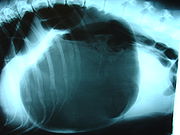
|

|
|
|
| ||
BloatThe most common sign of bloat
It is a good idea to discuss this possibility with your vet prior to facing an emergency. Wikipedia Definition of BloatThis is what "Wikipedia" says about Gastric Torsion, bloat is a medical condition in which the stomach becomes overstretched by excessive gas content. It is also commonly referred to as, gastric torsion, and gastric dilatation-volvulus (GDV) when the stomach is also twisted. The word bloat is often used as a general term to cover gas distension of the stomach with or without twisting. In dogs, gas accumulation in the stomach may cause or be caused by a volvulus, or twisting, of the stomach, which prevents gas from escaping. Deep-chested breeds are especially at risk. Mortality rates in dogs range from 10 to 60 percent, even with treatment. With surgery, the mortality rate is 15 to 33 percent. The five breeds at greatest risk are Great Danes, Weimaraners, St. Bernards, Gordon Setters, and Irish Setters. In fact, the lifetime risk for a Great Dane to develop bloat has been estimated to be close to 37 percent. Standard Poodles are also at risk for this health problem, as are Doberman Pinschers and Rottweilers. Basset Hounds have the greatest risk for dogs less than 23 kg/50 lbs. This is an X-ray of a dog with bloat. Note the classic "double bubble" pattern indicating that stomach torsion has occurred in this case. This is an X-ray of a dog with bloat. Note the classic "double bubble" pattern indicating that stomach torsion has occurred in this case.Causes of Gastric TorsionGastric Torsion in dogs is likely caused by a multitude of factors, but in all cases the immediate prerequisite is a dysfunction of the sphincter between the esophagus and stomach and an obstruction of outflow through the pylorus. Some of the more widely acknowledged factors for developing bloat include increased age, breed, having a deep and narrow chest, stress, eating foods such as kibble that expand in the stomach, overfeeding, and other causes of gastrointestinal disease and distress. Studies have indicated that the risk of bloat in dogs perceived as happy by their owners is decreased, and increased in dogs perceived as fearful. This may be due to the physiological effects of the dog's personality on the function and motility of the gastrointestinal system. Dogs with inflammatory bowel disease may be at an increased risk for bloat. End of quote from Wikipedia" During Gastric Torsion the stomach fills with gas and, for some as yet unknown reason, cannot expel the gas. Shock will be the first life-threatening event that happens in your dog. This is because the swollen stomach puts pressure on the large veins in the abdomen that carry blood back to the heart. Without proper return of blood, the output of blood from the heart is diminished, and the tissues are deprived of blood and oxygen. This will cause the stomach wall to be deprived of adequate circulation. If the blood supply is not quickly returned, the walls of the stomach begin to die and the wall may rupture. If volvulus (a twisting of the intestine upon itself that causes obstruction) occurs, the spleen's blood supply will also be impaired. This organ is attached to the stomach wall and shares some large blood vessels. When the stomach twists, the spleen is also rotated to an abnormal position and its vessels are compressed. When the stomach is distended, digestion stops. This results in the accumulation of toxins that are normally removed from the intestinal tract. These toxins activate several chemicals which cause inflammation, and the toxins are absorbed into circulation. This causes problems with the blood clotting factors so that inappropriate clotting occurs within blood vessels. This is called disseminated intravascular coagulation (DIC) and is usually fatal. To date the causes are still unknown. The Purdue study has suggested that dogs fed a diet full of variety and who have calmer dispositions are at a lesser risk. Feeding a minimum of 2 meals a day, waiting 1 hour before and after feeding to exercise, and perhaps soaking the food are also thought to be of some help to prevent bloat. The most effective preventative is a gastropexy. This is a surgical procedure where the stomach wall is securely attached to the abdominal wall. The adhesions formed after surgery further help to anchor the stomach so it cannot torsion. You should discuss this procedure with your vet. In a study of bloat conducted at the Veterinary school at Purdue University, purebred dogs were 3 times more likely to bloat as were mixed breed dogs! 2 Important Reminders

Homepage | Best Dog for Kids | Animal Rescue Site | Link to Us
Great Dane Puppies | Great Dane History | Great Dane Introduction | Therapy Dogs | Great Dane Training | Great Dane Dogs | Great Dane Blog | Great Dane Care | Pack Leader | Volvulus Bloat Scale | Ear Cropping | Bloat | Helpful Links | Harlequin | Puppy Mills | |   Click Here to Vote for My Site! Click Here to Vote for My Site!
HyperadrenocorticismHyperadrenocorticism is also known as Cushing’s disease. Hyperadrenocorticism may be the most frequent endocrinopathy (a disease of an endocrine gland, a medical term for a hormone problem) in adult to aged dogs but is infrequent in other domestic animals. Preventive Methods for BloatResearch has confirmed that the structure of deep-chested breeds contributes to their predisposition to bloat. Nevertheless, there are precautions that you can take to reduce the risk.
 Symptoms of Cushing’s diseaseCommon symptoms include, polyuria (increased urination), polydipsia (increased water intake), polyphagia (increased appetite), bald patches - or general hair loss, usually accompanied by a "pot" belly (though the dog appears normal weight elsewhere). The clinical signs and lesions result primarily from chronic excess of cortisol. Increased cortisol levels in dogs may result from one of several mechanisms. The most common is an adenoma or hyperplasia of the adrenocorticotropic hormone (ACTH)-containing cells of the pituitary gland, which results in bilateral adrenal cortical hypertrophy and hyperplasia. This form of the disease is referred to as pituitary-dependent hyperadrenocorticism (Cushing’s disease) and occurs in 90% of cases. Functional adrenal tumors, a far less frequent cause of hyperadrenocorticism in dogs, may secrete cortisol or sex steroids resulting in a variety of clinical signs. | |
| | ||
Bloat Beginning Welcome to the World of the Great Dane.This website strives to bring you the latest information on Great Danes. The content is updated often so make sure and bookmark this site so you can keep up to date on the information. Link To UsReturn to top The Content of this Website is intended as General Information and is NOT Professional Advice. | ||
| | ||



